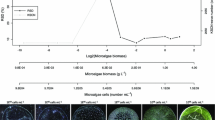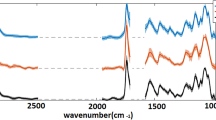Abstract
The unicellular photosynthetic organisms known as microalgae are becoming one of the most important models for aquatic system studies. Among them, Chlamydomonas reinhardtii is widely used as a bioindicator of pollution or of different changes in the environment. Numerous pollutants are present in aquatic environments, particularly plastics and nanoplastics. Physiological variations after an environmental change highlight variation in the macromolecular composition of microalgae (proteins, nucleic acids, lipids and carbohydrates). Recently, Fourier transform infrared vibrational spectroscopy has been described as a reliable tool, sensitive and allowing rapid measurement of macromolecular composition of microalgae. Coupled with preprocessing and principal component analysis, it is well adapted to monitoring the effect of environmental stress on biochemical composition. In this study, infrared spectroscopy, combined with multivariate analysis, has been tested first on known environmental stresses such as light intensity variation and nitrogen limitation. Then, this technique has been applied to monitor the interaction and potential impacts of polystyrene nanoparticles on microalgae. The results showed slight variations on protein and carbohydrates bands in the presence of nanoplastics, suggesting that their presence led to modifications in the biochemical composition of the microalgae. To confirm the interaction between microalgae and nanoplastics, visualization by confocal microscopy and cytotoxicity measurement has been carried out. Results showed that polystyrene nanoparticles seemed to adsorb on microalgae surface, leading to a loss of plasma membrane integrity. The resulting chemical modifications, even if moderate, could be detected by infrared spectroscopy‚ showing that this tool could be very helpful in the understanding of nanoparticle-microalgae interaction mechanisms.






Similar content being viewed by others
References
Irihimovitch V, Yehudai-Resheff S. Phosphate and sulfur limitation responses in the chloroplast of Chlamydomonas reinhardtii. FEMS Microbiol Lett. 2008;283:1–8. https://doi.org/10.1111/j.1574-6968.2008.01154.x.
Cid A, Prado R, Rioboo C, Suárez-Bregua P, Herrero C. Use of microalgae as biological indicators of pollution: looking for new relevant cytotoxicity endpoints. Microalgae Biotechnol Microbiol Energy 2013;311–324.
Morlon H (2005) Mécanismes de prise en charge du sélénite – Se(IV)- chez l’algue verte unicellulaire Chlamydomonas reinhardtii. Bioaccumulation et effets induits sur la croissance et l’ultrastructure. Université de Bordeaux 1.
Mata TM, Martins AA, Caetano NS. Microalgae for biodiesel production and other applications: a review. Renew Sust Energ Rev. 2010;4:217–32. https://doi.org/10.1016/j.rser.2009.07.020.
Minhas AK, Hodgson P, Barrow CJ, Adholeya A. A review on the assessment of stress conditions for simultaneous production of microalgal lipids and carotenoids. Front Microbiol. 2016;7:1–19. https://doi.org/10.3389/fmicb.2016.00546.
Nama S, Madireddi SK, Devadasu ER, Subramanyam R. High light induced changes in organization, protein profile and function of photosynthetic machinery in Chlamydomonas reinhardtii. J Photochem Photobiol B Biol. 2015;152:367–76. https://doi.org/10.1016/j.jphotobiol.2015.08.025.
Belotti G, De Caprariis B, De Filippis P, Scarsella M, Verdone N. Effect of Chlorella vulgaris growing conditions on bio-oil production via fast pyrolysis. Biomass Bioenergy. 2014;61:187–95. https://doi.org/10.1016/j.biombioe.2013.12.011.
Illman A, Scragg AH, Shales SW. Increase in Chlorella strains calorific values. Enzym Microb Technol. 2000;27:631–5. https://doi.org/10.1016/S0141-0229(00)00266-0.
Borowitzka MA, Huisman JM, Osborn A. Culture of the astaxanthin-producing green alga Haematococcus pluvialis. Effects of nutrients on growth and cell type. J Appl Phycol. 1991;3:295–304. https://doi.org/10.1007/BF02392882.
Chiu SY, Kao CY, Tsai MT, Ong SC, Chen CH, Lin CS. Lipid accumulation and CO2 utilization of Nannochloropsis oculata in response to CO2 aeration. Bioresour Technol. 2009;100:833–8. https://doi.org/10.1016/j.biortech.2008.06.061.
Dubois M, Gilles KA, Hamilton JK, Pa R, Smith F. Colorimetric method for determination of sugars and related substances. Anal Chem. 1956;28:350–6.
Smith P, Krohn RI, Hermanson GT, Mallia AK, Gartner FH, Provenzano M, et al. Measurement of protein using bicinchoninic acid. Anal Biochem. 1985;150:76–85.
Mitić Ž, Stolić A, Stojanović S, Najman S, Ignjatović N, Nikolić G, et al. Instrumental methods and techniques for structural and physicochemical characterization of biomaterials and bone tissue: a review. Mater Sci Eng C. 2017;79:930–49. https://doi.org/10.1016/j.msec.2017.05.127.
Jebsen C, Norici A, Wagner H, Palmucci M, Giordano M, Wilhelm C. FTIR spectra of algal species can be used as physiological fingerprints to assess their actual growth potential. Physiol Plant. 2012;146:427–38. https://doi.org/10.1111/j.1399-3054.2012.01636.x.
Wagner H, Liu Z, Langner U, Stehfest K, Wilhelm C. The use of FTIR spectroscopy to assess quantitative changes in the biochemical composition of microalgae. J Biophotonics. 2010;3:557–66.
Patel SA, Currie F, Thakker N, Goodacre R. Spatial metabolic fingerprinting using FT-IR spectroscopy: investigating abiotic stresses on Micrasterias hardyi. Analyst. 2008;133:1707–13. https://doi.org/10.1039/b809441a.
Driver T, Bajhaiya AK, Allwood JW, Goodacre R, Pittman JK, Dean AP. Metabolic responses of eukaryotic microalgae to environmental stress limit the ability of FT-IR spectroscopy for species identification. Algal Res. 2015;11:148–55. https://doi.org/10.1016/j.algal.2015.06.009.
Dean A, Nicholson J, Sigee D. Impact of phosphorus quota and growth phase on carbon allocation in Chlamydomonas reinhardtii: an FTIR microspectroscopy study. Eur J Phycol. 2008;43:345–54. https://doi.org/10.1080/09670260801979287.
Sigee DC, Bahrami F, Estrada B, Webster RE, Dean AP. The influence of phosphorus availability on carbon allocation and P quota in Scenedesmus subspicatus: a synchrotron-based FTIR analysis. Phycologia. 2007;46:583–92. https://doi.org/10.2216/07-14.1.
Meng Y, Yao C, Xue S, Yang H. Application of fourier transform infrared (FT-IR) spectroscopy in determination of microalgal compositions. Bioresour Technol. 2014;151:347–54. https://doi.org/10.1016/j.biortech.2013.10.064.
Stehfest K, Toepel J, Wilhelm C. The application of micro-FTIR spectroscopy to analyze nutrient stress-related changes in biomass composition of phytoplankton algae. Plant Physiol Biochem. 2005;43:717–26. https://doi.org/10.1016/j.plaphy.2005.07.001.
Jakob T, Wagner H, Stehfest K, Wilhelm C. A complete energy balance from photons to new biomass reveals a light- and nutrient-dependent variability in the metabolic costs of carbon assimilation. J Exp Bot. 2007;58:2101–12. https://doi.org/10.1093/jxb/erm084.
Ter Halle A, Jeanneau L, Martignac M, Jardé E, Pedrono B, Brach L, et al. Nanoplastic in the North Atlantic Subtropical Gyre. Environ Sci Technol. 2017;51:13689–97. https://doi.org/10.1021/acs.est.7b03667.
Phuong NN, Zalouk-Vergnoux A, Poirier L, Kamari A, Châtel A, Mouneyrac C, et al. Is there any consistency between the microplastics found in the field and those used in laboratory experiments? Environ Pollut. 2016;211:111–23. https://doi.org/10.1016/j.envpol.2015.12.035.
Sjollema SB, Redondo-Hasselerharm P, Leslie HA, Kraak MHS, Vethaak AD. Do plastic particles affect microalgal photosynthesis and growth? Aquat Toxicol. 2016;170:259–61. https://doi.org/10.1016/j.aquatox.2015.12.002.
Bhattacharya P, Sijie L, James PT, Pu Chun K. Physical adsorption of charged plastic nanoparticles affects algal photosynthesis. J Phys Chem C. 2010;114:16556. https://doi.org/10.1021/jp1054759.
Nolte TM, Hartmann NB, Kleijn JM, Garnæs J, van de Meent D, Jan Hendriks A, et al. The toxicity of plastic nanoparticles to green algae as influenced by surface modification, medium hardness and cellular adsorption. Aquat Toxicol. 2016;183:11–20. https://doi.org/10.1016/j.aquatox.2016.12.005.
Libralato G, Galdiero E, Falanga A, Carotenuto R, de Alteriis E, Guida M. Toxicity effects of functionalized quantum dots, gold and polystyrene nanoparticles on target aquatic biological models: a review. Molecules. 2017;22:1439. https://doi.org/10.3390/molecules22091439.
Bergami E, Pugnalini S, Vannuccini ML, Manfra L, Faleri C, Savorelli F, et al. Long-term toxicity of surface-charged polystyrene nanoplastics to marine planktonic species Dunaliella tertiolecta and Artemia franciscana. Aquat Toxicol. 2017;189:159–69. https://doi.org/10.1016/j.aquatox.2017.06.008.
Casado MP, Macken A, Byrne HJ. Ecotoxicological assessment of silica and polystyrene nanoparticles assessed by a multitrophic test battery. Environ Int. 2013;51:97–105. https://doi.org/10.1016/j.envint.2012.11.001.
Sack L, Zeyl C, Bell G, Sharbel T, Reboud X, Bernhardt T, et al. Isolation of four new strains of Chlamydomonas reinhardtii (Chlorophyta) from soil samples. J Phycol. 1994;30:770–3. https://doi.org/10.1088/1742-6596/194/4/042018.
Gorman SD, Levine RP. Cytochrome F and plastocyanin: their sequence in the photosynthetic electron transport chain of Chlamydomonas reinhardtii. Proc Natl Acad Sci. 1965;54:1665–9. https://doi.org/10.1104/pp.126.1.69.
Pakrashi S, Dalai S, TC P, Trivedi S, Myneni R, Raichur AM, Chandrasekaran N, Mukherjee A (2013) Cytotoxicity of aluminium oxide nanoparticles towards fresh water algal isolate at low exposure concentrations. Aquat Toxicol 132–133:34–45 . https://doi.org/10.1016/j.aquatox.2013.01.018.
Rammal A (2017) Mathématiques appliquées et traitement du signal pour l’évaluation de la dégradation de la biomasse lignocellulosique. Université de Reims Champagne-Ardenne.
Giordano M, Ratti S, Domenighini A, Vogt F. Spectroscopic classification of 14 different microalga species: first steps towards spectroscopic measurement of phytoplankton biodiversity. Plant Ecol Divers. 2009;2:155–64. https://doi.org/10.1080/17550870903353088.
Hu Q (2004) Environmental effects on cell composition. In: Handbook of microalgal culture: biotechnology and applied phycology, Richmond A. Oxford.
Benavente-Valdés JR, Aguilar C, Contreras-Esquivel JC, Méndez-Zavala A, Montañez J. Strategies to enhance the production of photosynthetic pigments and lipids in chlorophycae species. Biotechnol Reports. 2016;10:117–25. https://doi.org/10.1016/j.btre.2016.04.001.
Markou G, Angelidaki I, Georgakakis D. Microalgal carbohydrates: an overview of the factors influencing carbohydrates production, and of main bioconversion technologies for production of biofuels. Appl Microbiol Biotechnol. 2012;96:631–45. https://doi.org/10.1007/s00253-012-4398-0.
Wiercigroch E, Szafraniec E, Czamara K, Pacia MZ, Majzner K, Kochan K, et al. Raman and infrared spectroscopy of carbohydrates: a review. Spectrochim Acta - Part A Mol Biomol Spectrosc. 2017;185:317–35. https://doi.org/10.1016/j.saa.2017.05.045.
Mitić Ž, Nikolić GS, Cakić M, Premović P, Ilić L. FTIR spectroscopic characterization of cu(II) coordination compounds with exopolysaccharide pullulan and its derivatives. J Mol Struct. 2009;924–926:264–73. https://doi.org/10.1016/j.molstruc.2009.01.019.
He M, Yan Y, Pei F, Wu M, Gebreluel T, Zou S, et al. Improvement on lipid production by Scenedesmus obliquus triggered by low dose exposure to nanoparticles. Sci Rep. 2017;7:15526. https://doi.org/10.1038/s41598-017-15667-0.
Rueler JG, Ades DR. The role of iron nutrition in photosynthesis and nitrogen assimilation in Scenedesmus quadricauda (Chlorophyceae) 1. J Phycol. 1987;23:452–7.
Wagner H, Dunker S, Liu Z, Wilhelm C. Subcommunity FTIR-spectroscopy to determine physiological cell states. Curr Opin Biotechnol. 2013;24:88–94. https://doi.org/10.1016/j.copbio.2012.09.008.
Murdock JN, Wetzel DL. FT-IR microspectroscopy enhances biological and ecological analysis of algae. Appl Spectrosc Rev. 2009;44:335–61. https://doi.org/10.1080/05704920902907440.
Heraud P, Stojkovic S, Beardall J, McNaughton D, Wood BR. Intercolonial variability in macromolecular composition in P-starved and P-replete Scenedesmus populations revealed by infrared microspectroscopy. J Phycol. 2008;44:1335–9. https://doi.org/10.1111/j.1529-8817.2008.00564.x.
Suman TY, Radhika Rajasree SR, Kirubagaran R. Evaluation of zinc oxide nanoparticles toxicity on marine algae Chlorella vulgaris through flow cytometric, cytotoxicity and oxidative stress analysis. Ecotoxicol Environ Saf. 2015;113:23–30. https://doi.org/10.1016/j.ecoenv.2014.11.015.
Déniel M, Errien N, Daniel P, Caruso A, Lagarde F. Current methods to monitor microalgae-nanoparticle interaction and associated effects. Aquat Toxicol. 2019;217:105311. https://doi.org/10.1016/j.aquatox.2019.105311.
Zhang C, Wang J, Tan L, Chen X. Toxic effects of microplastic on marine microalgae Skeletonema costatum: interactions between microplastic and algae. Aquat Toxicol. 2016;178:158–64. https://doi.org/10.1016/j.aquatox.2016.07.020.
Mao Y, Ai H, Chen Y, Zhang Z, Zeng P, Kang L, et al. Phytoplankton response to polystyrene microplastics: perspective from an entire growth period. Chemosphere. 2018;208:59–68. https://doi.org/10.1016/j.chemosphere.2018.05.170.
Wang Z-H, Nie X-P, Yue W-J, Li X. Physiological responses of three marine microalgae exposed to cypermethrin. Int J Clin Exp Med. 2016;9:14247–53. https://doi.org/10.1002/tox.
Acknowledgments
The authors would like to thank Frédéric Amiard for their technical assistance during infrared measurement. Acknowledgements to plateforme “Spectroscopy” and plateforme “Matière Molle” of Institut Molécules et Matériaux du Mans of Le Mans University for their technical support.
Funding
This work was supported financially by Conseil départemental de la Sarthe, Le Mans Métropole and ANR CESA (ANR-15-CE34-0006-02, NANOPLASTICS project).
Author information
Authors and Affiliations
Corresponding author
Ethics declarations
Conflict of interest
The authors declare that they have no conflict of interest.
Additional information
Publisher’s note
Springer Nature remains neutral with regard to jurisdictional claims in published maps and institutional affiliations.
Rights and permissions
About this article
Cite this article
Déniel, M., Lagarde, F., Caruso, A. et al. Infrared spectroscopy as a tool to monitor interactions between nanoplastics and microalgae. Anal Bioanal Chem 412, 4413–4422 (2020). https://doi.org/10.1007/s00216-020-02683-9
Received:
Revised:
Accepted:
Published:
Issue Date:
DOI: https://doi.org/10.1007/s00216-020-02683-9




